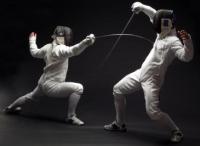Olympic logic
Can you use your powers of logic and deduction to work out the missing information in these sporty situations?
Problem
These four problems require some logical thinking and a willingness to work systematically.
Can you deduce the missing information in each sporty situation?
Perhaps you might develop techniques in one that will help you to solve another.
1. Medals Count
Given the following clues, can you work out the number of gold, silver and bronze medals that France, Italy and Japan got in this international sports competition?

- Japan has 1 more gold medal, but 3 fewer silver medals, than Italy.
- France has the most bronze medals (18), but fewest gold medals (7).
- Each country has at least 6 medals of each type.
- Italy has 27 medals in total.
- Italy has 2 more bronze medals than gold medals.
- The three countries have 38 bronze medals in total.
- France has twice as many silver medals as Italy has gold medals.
2. Football Champ

Three teams A, B and C have each played two matches.
Three points are given for a win and one point to each team for a draw.
The table below gives the total number of points and goals scored for and against each team.
Fill in the table and find the scores in each match.
| Teams | Games Played | Won | Drawn | Lost | Goals For | Goals Against | Points |
|---|---|---|---|---|---|---|---|
| A | 2 | 5 | 3 | 3 | |||
| B | 2 | 2 | 1 | ||||
| C | 2 | 3 | 2 | 4 |
3. Fencing Tournament
Alice, Becky, Charlotte, Daphne, Elsie and Fran decide to compete in a fencing tournament. Each competitor has to fence against every other competitor. A match results in either a win or a loss.
- Image

No competitor lost all their matches, but one person won all their matches.
- Daphne won her match against Becky.
- Alice and Elsie won the same, odd, number of matches, but Alice lost to Elsie.
- Becky and Fran won a total of seven matches
- Charlotte won only one match, against the only other person who also won only one match.
Can you deduce what all of the results were?
4. Hockey

In a hockey competition, four teams were to play each other once. 2 points were awarded for a win, and 1 point for a draw.
After some of the matches were played, most of the information in the results table was accidentally deleted.
| Team | Played | Won | Drawn | Lost | For | Against | Points |
|---|---|---|---|---|---|---|---|
| A | 4 | 4 | |||||
| B | 5 | 5 | |||||
| C | 0 | 4 | 2 | ||||
| D | 0 | 3 | 0 |
Can you work out the score in each match played?
Getting Started
Work out what each part of the problem tells you, and write it down.
What can you work out from what you know? Write down any new information that you deduce.
Can you think of any clear ways of representing the information?
Student Solutions
Wow, we received lots of solutions to this problem! It offered a good opportunity to think in a logical, systematic way.
Lots of people got the answer to Medals Count right. Rachel, at Milton Keynes Academy, gave us a great explanation of her method:
There are 38 bronze medals in total for the 3 countries. France has 18 of them, so there are 20 bronze medals between Italy and Japan. These are the possible combinations, needing to be over 6:
Italy: either 6, 7, 8, 9, 10, 11, 12 , 13 or 14 bronze
Japan: 14, 13, 12, 11, 10, 9, 8, 7 or 6 bronze
Italy must have at least 8 gold, because they have more than France (who have 7). So, they need to have at least 10 bronzes as they have 2 more bronzes than golds. This means that Italy has at most 9 silvers.
Japan has at most 10 bronzes because there are 20 bronzes between Japan and Italy. They have one more gold than Italy, giving Japan at least 9 golds. Japan also have 3 less silvers than Italy, giving them at most 6 silvers. France has twice as many silvers as Italy has golds (8x2 = 16), so France has at least 16 silvers.
Now let's explore the possibilities for Italy's bronze medals. Italy can have 10, 11, 12, 13 or 14 bronzes. But if Italy has 11 or more bronzes, then it has 9 or more golds, and so it has at most 7 silvers. This means that Japan has at most 4 silvers, which isn't allowed. So Italy must have 10 bronzes exactly.
In conclusion:
Italy: 10 bronzes 9 silvers 8 golds
Japan: 10 bronzes 6 silvers 9 golds
France: 18 bronzes 16 silvers 7 golds
Excellent! Luke, from Cottenham Village College, did things more algebraically:
First, give the number of medals names:
| gold | silver | bronze | |
| France | a | b | c |
| Japan | d | e | f |
| Italy | g | h | i |
Now apply the rules given:
From rule 1: g=d-1, h=e+3
From rule 2: c=18, a=7
From rule 5: i=d+1
From rule 7: b=2d-2
The table now looks like this:
| gold | silver | bronze | |
| France | 7 | 2d-2 | 18 |
| Japan | d | e | f |
| Italy | d-1 | e+3 | d+1 |
Apply rule 6: f+d+1+18=38, and the table looks like:
| gold | silver | bronze | |
| France | 7 | 2d-2 | 18 |
| Japan | d | e | 19-d |
| Italy | d-1 | e+3 | d+1 |
As France has the fewest golds, d-1 must be at least 8 so d is at least 9.
As 2d+e+3 = 27 (rule 4), and e must be at least 6 (Japan must have at least 6 silver medals: rule 3), we see that d = 9.
This makes e = 6.
The table finally looks like this:
| gold | silver | bronze | |
| France | 7 | 16 | 18 |
| Japan | 9 | 6 | 10 |
| Italy | 8 | 9 | 10 |
Great - thanks! How about Football Champ? The Year 9 class at Ounsdale High School showed us their method:
- Josh said that to work out the wins, draws and losses we looked at the points and the only possibilities are given below.
- B and C must have drawn because they each had 1 draw.
- A must have beaten B, and C must have beaten A.
- Jordan said: the maximum that team B could have scored in their draw was 2, so it was either 2 - 2 or 1- 1.
- As C only let in 2 goals in total, and C must have scored at least one goal against A, the same between B and C must have ended up 1-1.
- Total number of goals for and against must be equal, because if A scored against B it would count for A and against B, for example.
And their results were as follows:
| Teams | Games Played | Won | Drawn | Lost | Goals For | Goals Against | Points |
|---|---|---|---|---|---|---|---|
| A | 2 | 1 | 0 | 1 | 5 | 3 | 3 |
| B | 2 | 0 | 1 | 1 | 2 | 5 | 1 |
| C | 2 | 1 | 1 | 0 | 3 | 2 | 4 |
Nicely done!
For the Fencing Tournament problem, Szymon from Earl Mortimer College recommends making a table. He explains his method as follows:
Tip 2 says 'Daphne won her match against Becky'. Mark this in the table as follows:
| A | B | C | D | E | F | |
| A | ||||||
| B | Image
| |||||
| C | ||||||
| D | Image
| |||||
| E | ||||||
| F |
- Tip 3: 'Alice and Elsie won the same, odd, number of matches, but Alice lost to Elsie'. You know that Elsie won against Alice, so you can plot these straight away. Now, they won either 1, 3 or 5 games each, but it can't be five, because only one person could have won all their matches.
- Tip 5 says Charlotte won only one match, against the other person who won only one as well. We don't know who this is, but there is only one of them, so it can't be Alice and Elsie, so they must have won 3 of their matches...
If you keep using the tips in this logical way, the eventual table of answers looks as follows:
| A | B | C | D | E | F | |
| A | Image
| Image
| Image
| Image
| Image
| |
| B | Image
| |||||
| C | ||||||
| D | ||||||
| E | ||||||
| F |
Thanks! Finally, the Hockey problem - this was tough! A bit of careful reading tells you that the results given are only a partial list of results - some games may not have been played yet. Samantha, from Laxey Primary School, gives her answer as follows:
| Team | Played | Won | Drawn | Lost | For | Against | Points |
| A | 3 | 1 | 1 | 1 | 4 | 4 | 3 |
| B | 3 | 2 | 1 | 0 | 5 | 2 | 5 |
| C | 2 | 0 | 2 | 0 | 4 | 4 | 2 |
| D | 2 | 0 | 0 | 2 | 0 | 3 | 0 |
and the individual results:
A v B: B wins 2-0
A v C: draw 2-2
A v D: A wins 2-0
B v C: draw 2-2
B v D: B wins 1-0
C v D: not played yet.
Thanks to everyone who sent in solutions this month!
Teachers' Resources
Why do this problem?
These four problems require some logical thinking and a willingness to work systematically. Routes to a solution are not immediately obvious so working on the problems could help students to develop their resilience, an important quality for mathematical problem-solvers.
Possible approach
Before introducing the task:
"Mathematicians need to be resourceful problem-solvers who don't give up, who talk to each other and share good ideas, who work strategically and systematically. The answers won't be immediately obvious, so these problems will test your ability to work as mathematicians."
The problems could be used in several ways:
Hand out this worksheet and invite students to work on all four problems in pairs.
Cut the worksheet into the four separate problems and invite different groups to work on different problems.
Work on one or two of the questions together as a class and then invite students to use each other's useful insights to solve the remaining problems.
While students are working, circulate and listen for useful insights. Where appropriate, bring the class together so that students can share successful strategies with the rest of the class.
Key questions
What do you know? Write it down.
What can you deduce from what you know? Write it down.
Is there a good way of representing what you know, to make it clear?
Possible extension
For other problems that require systematic and logical thinking see Two and Two, Product Sudoku and Cinema Problem.
Possible support
Of the four problems, Football Champ and Hockey use very similar techniques, so one could be solved as a class before students are given the second to apply any useful methods they have devised.
